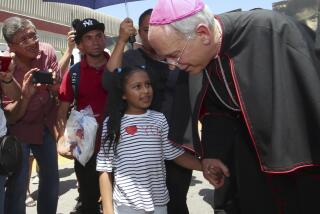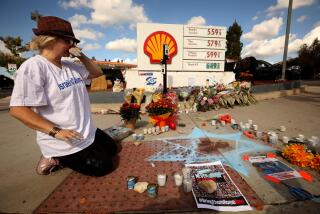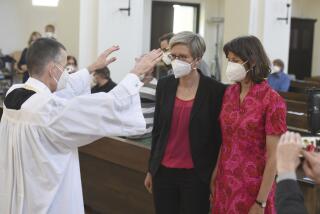Catholic Church Widens Outreach to Other Faiths
- Share via
Thirty years after the Second Vatican Council added interfaith dialogue to the Roman Catholic agenda, the changing American religious scene has profoundly altered the American church’s outreach to other religious groups.
Where once Catholic interfaith dialogue largely meant conversation with Jews, mainline Protestant and Eastern Orthodox Christians, today it also means growing relationships with Muslims and evangelical Protestants. There also have been halting attempts at establishing ties with Hindus and Buddhists.
Interfaith dialogues are always tricky, and the church’s newer efforts in this regard are far from problem-free. Evangelicals fear having to make theological compromises, and Catholic leaders bemoan the difficulty of finding dialogue partners among the myriad of Hindu and Buddhist sects.
Events halfway around the globe can also affect delicate domestic efforts. What the Vatican says in regard to the Middle East impacts the church’s domestic dialogue with both Jews and Muslims. American Buddhists joined Buddhists worldwide in voicing their displeasure with remarks by Pope John Paul II in his book “Crossing the Threshold of Hope,” which they viewed as insulting to their faith.
Interfaith events are part of virtually every papal trip, as they will be during Pope John Paul II’s visit next week to New York, New Jersey and Maryland.
The Pope will meet with non-Catholic Christians, Muslims and Jews in New York City next Saturday evening, a gathering that will include television evangelist Pat Robertson, the Rev. Joan Brown Campbell of the National Council of Churches, and Rabbi A. James Rudin of the American Jewish Committee. The next day in Baltimore he will preside over an inclusive worship service to which regional interfaith representatives have been invited.
Real dialogue, however, is not on the agenda. The New York meetings are little more than formal handshakes--15-minute sessions at the residence of Cardinal John O’Connor, the archbishop of New York, at which the Pope will exchange greetings with a small number of representatives of the other faiths.
There will be even less interaction in Baltimore, where the Pope will deliver a short address to those assembled at the Cathedral of Mary Our Queen, hear some words of welcome in response and shake a few hands.
But even these ceremonial exchanges, squeezed into a typically crowded papal schedule, “show the Pope’s commitment to the process of dialogue,” said the Rev. James F. Loughran, the New York Archdiocese’s ecumenical and inter-religious affairs director.
The point is to set a tone for the church. The real work is done by the bishops, priests and lay professional staffs. In recent years, that work in the United States has mushroomed.
“The more long-running dialogues, such as that with Jews, are of no less importance to us,” said Eugene Fisher, associate director of the National Conference of Catholic Bishops’ Secretariat for Ecumenical and Interreligious Affairs. “We have just had to add more, which just makes us that much more spiritually enriched.”
Perhaps the most visible sign of the church’s increased efforts at dialogue is its growing attention to the burgeoning American Muslim community, now estimated at between 3 million and 5 million members.
When John Paul visited the United States in 1987, he met with non-Catholic Christians in Columbia, S.C., and with national Jewish leaders in Miami. Some Jewish leaders came close to boycotting that session, largely because of their unhappiness over the Pope’s meeting with former Austrian President Kurt Waldheim, who served in the German army in World War II. No such burning issue separates Jews from the Vatican today.
Muslims in 1987 were relegated to a papal meeting with local religious leaders in Los Angeles that also included Jewish, Buddhist and Hindu representatives.
This time, the pontiff’s New York schedule treats Muslims on par with non-Catholic Christians and Jews.
“It’s a real signal of what’s happening religiously and politically within the church and all across the United States,” said John Esposito, director of the Center for Christian-Muslim Understanding at Georgetown University, a Catholic institution in Washington.
“For Catholics and everyone else, Muslim inclusion is now seen as a matter of course.”
The National Conference of Catholic Bishops has been engaged in official dialogue with Muslims since 1987, when it added a staff position in its Washington office primarily for that purpose. Since then, the American church and Muslim groups have jointly opposed the 1991 Desert Storm assault on Iraq, and they have come together in various contexts in opposition to abortion and in support of conservative family values.
In August, American Muslim leaders met in Baltimore with Cardinal William Keeler, the bishops’ conference president, and Cardinal Francis Arinze, president of the Vatican’s Pontifical Council for Inter-Religious Dialogue. Muslim and Catholic leaders regard that meeting as perhaps their most important to date in this country.
Catholic-Muslim dialogue has also blossomed on a local level. In Los Angeles, it has gone on far longer than it has on the national level.
However, local dialogues are often fragile affairs. “It depends very much who is in place in any particular diocese as to whether anything takes place or not,” said Dr. Maher Hathout, a Muslim who is president of the Los Angeles Interreligious Council. “We are still too dependent upon personalities.”
For Catholics and evangelical Protestants, the road to dialogue has been theologically rocky, despite their increased cooperation in the political arena on such issues as opposition to abortion and homosexual rights. The issue is so sensitive for evangelicals concerned about theological compromise that contacts have largely been restricted to the unofficial sphere.
Southern Baptists are so skittish over the possibility of theological compromise that the 15.6-million-member denomination’s interfaith department shies away from even using the word dialogue, labeling its official contacts with Catholics “conversations” instead.
When it comes to Buddhists and Hindus, Catholic officials say their attempts at official dialogue are hampered by a lack of readily identifiable representatives of those faiths--both of which largely consist in this country of relatively recent immigrants.
However, Buddhists and Hindus, noting the wide unofficial contacts that Catholic theologians and monastics have had with the Eastern faiths over the years, say church leaders just need to look a little harder.
“They know who we are,” said H. Ratanasara, a Sri Lankan-born Buddhist monk in Los Angeles who is executive president of the American Buddhist Congress, which consists of nearly 60 Buddhist groups divided along ethnic and sectarian lines. There are more than 3 million Buddhists in the United States.
“We have been here for 17 years and have serviced thousands of Hindus in that time,” said Dr. Uma Mysorekar, president of the Hindu Temple of New York, which operates the nation’s oldest Hindu temple, located in New York City’s Flushing section.
“How much further do they need to look?” said Mysorekar, who is also secretary of the Council of Hindu Temples of North America. There are about 1.2 million American Hindus.
Both Ratanasara and Mysorekar expressed disappointment with official Catholic attitudes toward their faiths. “It’s a matter of understanding,” Ratanasara said. “Even the Pope does not truly understand Buddhist doctrine.”
The Pope’s comment in “Crossing the Threshold of Hope” that Buddhism is an “atheistic” system “indifferent to the world” prompted Buddhist leaders to boycott the pontiff’s visit to Sri Lanka this year. Since then, Catholic officials have met with Buddhist leaders to defuse their anger.
However, Ratanasara said such “deep-seated” misunderstandings “are far from resolved. Catholics and Buddhists are just at the beginning of talking to each other, in the United States and around the world. It will be a long time before there is true understanding.
“I hope they try,” he said. “The Catholic Church is so important.”
More to Read
Sign up for Essential California
The most important California stories and recommendations in your inbox every morning.
You may occasionally receive promotional content from the Los Angeles Times.










